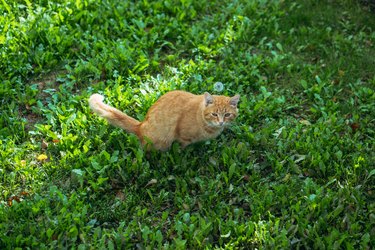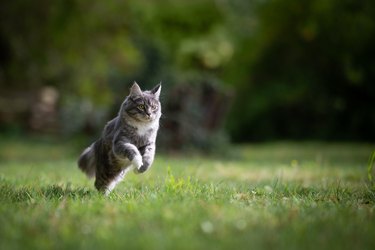
The lush foliage and flowers of your favorite potted plants fill a bright corner, but when you get a whiff of the surrounding air, it becomes obvious that the cat peed in a plant. Maybe more than one. The ammonia stench of urine can be overpowering, and it's not good for your plants. With a few simple measures, you can get the smell of cat urine out of the potting soil and prevent a stinky repeat performance by your kitty.
When Your Cat Peed in a Plant
Video of the Day
Before you begin, put on gloves, safety goggles and a dust mask to protect your hands, eyes and lungs while moving your plants around. Spread newspapers over your work area if you're going to repot the plant. If you're moving a large plant, use a dolly or recruit a helper.
Video of the Day
Locate the plant that attracted the kitty's attention. A cautious sniff, white salts on the top of the soil or disturbed potting soil should identify the plant. Check all the other plants; the cat may have used more than one as a litter box.
Remove any feces along with the surrounding soil and put it in the trash. Feces may contain parasites; avoid breathing the dust or handling fecal matter without protective gear.
Mitigate the Damage

Cat urine leaves alkaline salts and nitrogen in the soil, which damages the plant's roots. The best way to remove the salts is to leach them out with plenty of water. The excess water must be able to drain completely from the potting soil in order to flush out the salts.
Place the plant in the sink, or if it's in a large pot, outside in a shady, sheltered area. Fill the flowerpot to the rim with fresh water, then leave the faucet or hose dribbling slowly over the soil for approximately one hour. You can also add a tablespoon of white vinegar to the water in the top of the pot to help cut the stench of ammonia and discourage repeat performances by the cat.
Repot the Plant
If the smell doesn't dissipate or the plant is showing signs of salt damage, repotting is a viable alternative. Prepare a new flowerpot or carefully slide the plant with its root ball out of the pot. Scrub the old or recycled flowerpot with a brush and dishwashing liquid and sterilize by dipping the entire pot into a solution of 1 part chlorine bleach and 9 parts water. Soak for 10 to 15 minutes, then rinse thoroughly and allow to air dry.
While the pot is drying, carefully crumble the potting soil around the roots to remove as much of the mix as possible. Rinse the roots under lukewarm running water, then immediately plant in fresh, moist potting mix. Don't let the roots dry out. Water thoroughly and, if possible, put the plant out of reach of the cat.
Prevent Future Incidents

After flushing the potting soil with water and/or repotting the plant, place rocks or pinecones on top of the potting soil to prevent easy access to the mix. A piece of aluminum foil, chicken wire or window screen cut to size and placed in the top of the flowerpot and over the potting mix may also discourage the cat.
Prevent future incidents of the cat peeing in the potting soil by keeping its litter box clean. The cat may object to the cleanliness, location or type of kitty litter. If you have more than one cat, they may need multiple litter boxes; not all cats are willing to share. In addition, if the cat continues to urinate outside of the litter box, take it to the veterinarian – the cat may be suffering from a urinary tract infection.